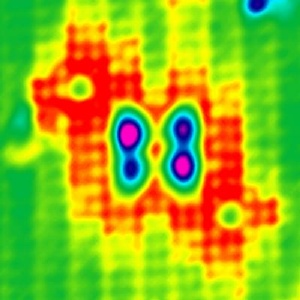Jan 27 2009
Single atom quantum dots created by researchers at Canada's National Institute for Nanotechnology and the University of Alberta make possible a new level of control over individual electrons, a development that suddenly brings quantum dot-based devices within reach. Composed of a single atom of silicon and measuring less than one nanometre in diameter, these are the smallest quantum dots ever created.
 Four atomic quantum dots are coupled to form a "cell" for containing electrons. The cell is filled with just two electrons. Control charges are placed along a diagonal to direct the two electrons to reside at just two of the four quantum dots comprising the cell. This new level of control of electrons points to new computation schemes that require extremely low power to operate. Such a device is expected to require about 1,000 times less power and will be about 1,000 times smaller than today's transistors. Credit: Robert A. Wolkow
Four atomic quantum dots are coupled to form a "cell" for containing electrons. The cell is filled with just two electrons. Control charges are placed along a diagonal to direct the two electrons to reside at just two of the four quantum dots comprising the cell. This new level of control of electrons points to new computation schemes that require extremely low power to operate. Such a device is expected to require about 1,000 times less power and will be about 1,000 times smaller than today's transistors. Credit: Robert A. Wolkow
Quantum dots have extraordinary electronic properties, like the ability to bottle-up normally slippery and speedy electrons, that allow controlled interactions among electrons to be put to use to do computations. Until now, quantum dots have been useable only at impractically low temperatures, but the new atom-sized quantum dots perform at room temperature.
Often referred to as artificial atoms, quantum dots have previously ranged in size from 2-10 nanometers in diameter. While typically composed of several thousand atoms, all the atoms pool their electrons to "sing with one voice", that is, the electrons are shared and coordinated as if there is only one atomic nucleus at the centre. That property enables numerous revolutionary schemes for electronic devices.
Research project leader Robert A. Wolkow described the potential impact saying, "Because they operate at room temperature and exist on the familiar silicon crystals used today's computers, we expect these single atom quantum dots will transform theoretical plans into real devices."
The single atom quantum dots have also demonstrated another advantage – significant control over individual electrons by using very little energy. Wolkow sees this low energy control as the key to quantum dot application in entirely new forms of silicon-based electronic devices, such as ultra low power computers. "The capacity to compose these quantum dots on silicon, the most established electronic material, and to achieve control over electron placement among dots at room temperature puts new kinds of extremely low energy computation devices within reach."
The single atom quantum dots and their ability to control electrons is the focus of a paper titled "Controlled Coupling and Occupation of Silicon Atomic Quantum Dots at Room Temperature" posted January 27, 2009 in the on-line edition and published in the January 30, 2009, edition of Physical Review Letters.